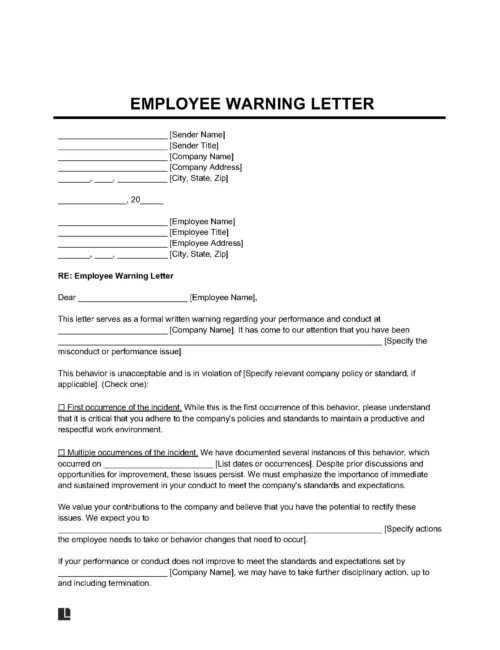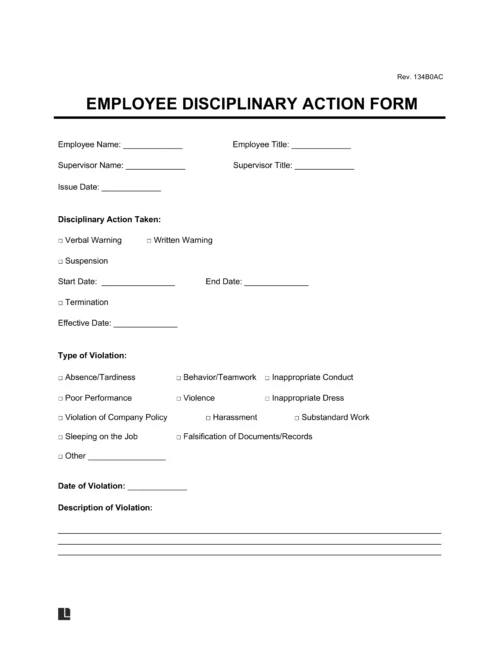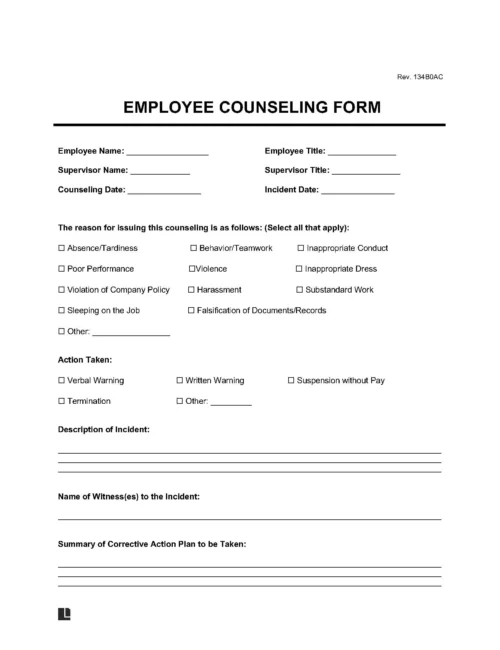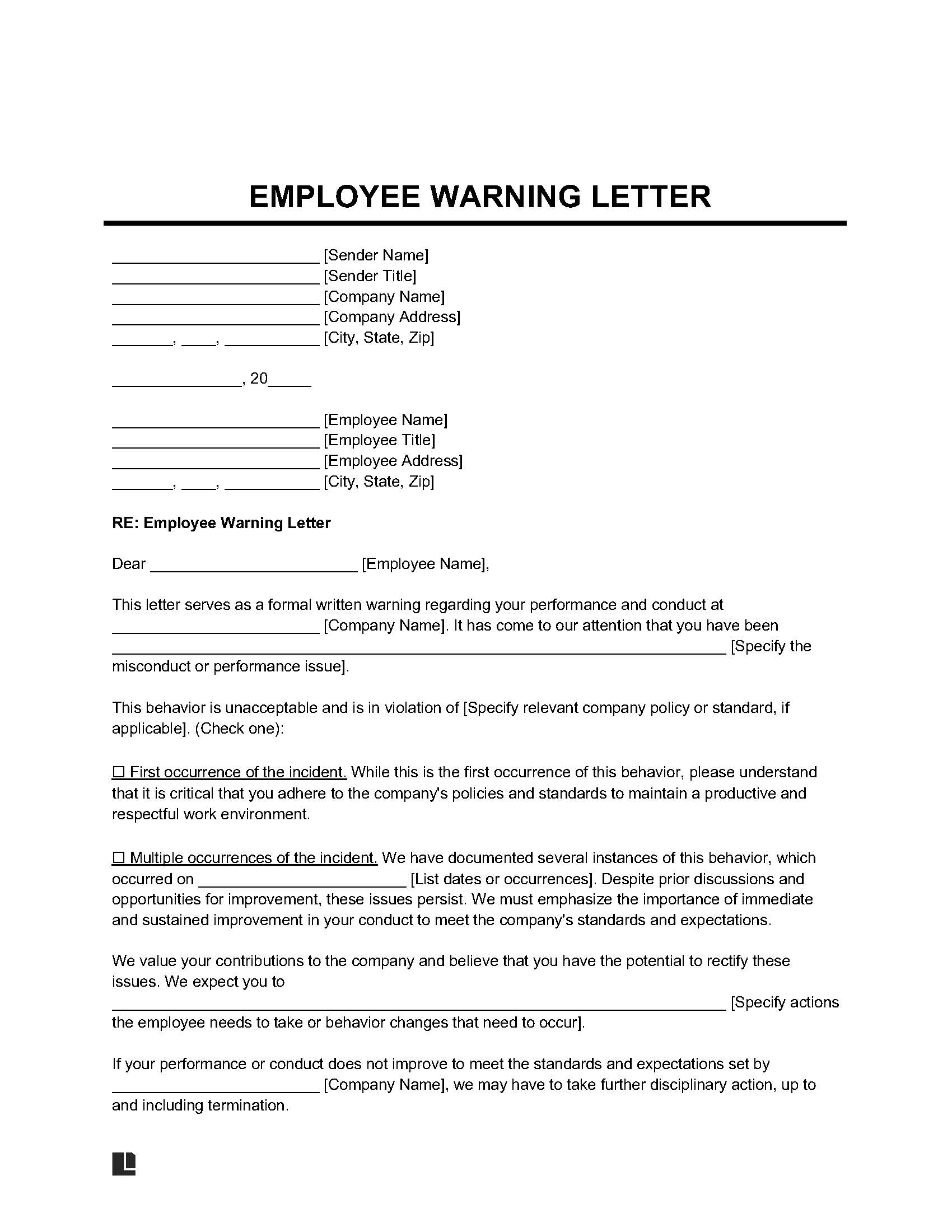Types of Employee Write-Up Forms
The proper write-up form depends on what happened and what action you plan to take next. Choose from our employee write-up templates to create a form that fits your situation, such as:
What Is an Employee Write-Up Form?
An employee write-up form records problems like missed deadlines, rule-breaking, or poor performance. It usually comes after a verbal warning and gives you a written record of what happened.
These forms help in employee evaluations to show past issues and solutions.
With Legal Templates, you can customize the write-up form to meet your needs and create consistent records.
Why Use an Employee Write-Up Form?
An employee write-up form helps you handle problems fairly, consistently, and legally. It shows that you gave a clear warning, followed company policy, and allowed the employee a chance to improve.
If the issue continues, you’ll have written proof of what happened and how you responded. Without a write-up, it’s harder to track repeated problems or defend your actions later.
Preventing Employee Issues
Establish HR policies for your startup or provide an employee handbook to create consistent and easy-to-reference expectations.
When to Use an Employee Write-Up Form
Use a write-up for issues that a verbal warning can’t solve. These forms help you document the situation, explain expectations, and take action. Safety or legal issues may require an incident report for a more appropriate solution.
Lack of Respect
Employees who show a lack of respect for coworkers, superiors, or customers may need a write-up. Pointing out and fixing the issue creates mutual respect and an enjoyable workplace. Examples of situations where a lack of respect requires a write-up include:
-
Displaying a constant negative attitude
-
Providing argumentative responses to requests
-
Ignoring or discrediting others
-
Showing bias or expressing dislike for others
Attendance Issues
An employee who is often absent or late or leaves early causes discontent and increases the workload for others. Employee write-ups inform employees of their tardies or absences and warn them of the consequences. Provide a write-up to show your awareness of the situation and allow them to address their schedule.
Poor Work Performance
Each employee’s performance affects the company as a whole. The employee may not realize their work is subpar. Begin with informal communication to help them improve. If the problem persists, a formal write-up for poor work performance may help motivate the employee to improve.
If that doesn’t work, you have the documentation to demote, discipline, or terminate the employee. Examples of poor performance include bad time management, failure to meet deadlines, and low quality of work.
Insubordination
Insubordination in a work environment leads to disharmony and miscommunications. Writing up an insubordinate employee ensures they understand the consequences of their actions. It also shows all employees that you will not tolerate that behavior. Insubordination write-ups apply to a variety of incidents, such as:
-
Failing to listen to supervisors/managers
-
Challenging reasonable actions/instructions
-
Refusing to complete sensible tasks
-
Speaking disrespectfully to superiors
Rude Behavior
Employee’s rude behavior impacts the morale and attitude of the entire team. Allowing employees to correct themselves through a write-up keeps the issue from growing. Examples of rude behavior in the workplace include:
-
Talking over others
-
Refusing to accommodate reasonable requests
-
Harmful or harsh language toward others
-
Namecalling or harassing others
Lying
Lying in the workplace can lead to safety concerns, damaged relationships, and lower morale. Addressing an employee who lies shows your commitment to honesty and allows them to take ownership of their mistakes. Harmful lies in the workplace include false updates, fake reports, or wrong product information.
Stealing
Stealing in the workplace leads to financial losses, such as a decrease in cash flow or equipment replacement costs. It damages a company’s reputation, as clients may not want to do business with the organization. When you issue employee write-ups for stealing, you set the precedent that you won’t tolerate it in your workplace.
Watch for employees who use work hours for personal matters or incorrectly report their time worked. Write up employees who steal company time to serve as a warning and record of issues.
Policy Non-Compliance
Each employee agrees to the company policy at the start of their employment. Non-compliance with the agreement warrants a write-up detailing the infraction and recording behaviors. Ensure your employee understands the policy violation before you start a formal write-up. Having a previous warning makes it clear that a write-up is appropriate for continued non-compliance.
This lets you see and record if an employee breaks many rules over time. Common cases of policy non-compliance include:
-
Disobeying dress code
-
Not adhering to safety procedures
-
Plagiarism
-
Failing to report work or issues
How to Write Up an Employee
Writing up an employee doesn’t have to be complicated. With the correct information, you can record their behaviors and make adequate corrections. Follow these simple steps to write up an employee.
1. Issue a Verbal Warning
Start with a verbal warning before issuing an employee write-up form. This will make the employee aware of their mistake and allow them the chance to correct it. Telling them to stop or adjust their behavior may inspire them to fix the situation.
2. Wait Until You Are Calm
Issues with an employee involve high emotions. If you feel upset, wait until you calm down before entering the details into an employee write-up form. This lets you look at the situation without bias or personal interference. A write-up free of emotional language protects you from wrongful termination claims. Plus, it strengthens your case against any claims of retaliation.
3. Consult HR
Consulting with the human resources department ensures that the employee violated the policy. It also confirms the standard procedure for employee write-ups and provides increased consistency. HR may check for legal compliance and professionalism to prevent disputes.
4. Document the Issues
Your write-up form should document the incident details. Include the date of the incident and provide information about the employee’s actions. Get witness accounts or record the names of others who saw the event.
5. Refer to Company Policies
In the event description, mention any relevant company policies. Refer to the employee handbook to build your case and show the employee their violation. These sources may also provide information about suggested consequences or corrective actions.
6. Include Witness Statements
Add witness statements whenever possible, especially if the supervisor is not the main reporter. While a superior creates employee write-ups, they may not have seen the event. Having a statement from someone who saw the incident strengthens the report’s validity.
7. Meet with the Employee
Once you have the completed write-up form, plan a meeting with the employee to review it. Work with them to find a convenient time and arrange a private meeting. Review the form with them to make them aware of the reasoning for the write-up. Also, collaborate with them to develop a plan to resolve the issue. Have the employee sign and add the form to their file for future reference.
Next Steps After Writing Up an Employee
After issuing an employee write-up form, take the next steps to follow up on the :
-
Maintain documents: Keep a copy of the form in the employee’s personnel file.
-
Follow-up: Schedule follow-up calls to check employee progress and address concerns.
-
Support employees: Provide training or mentoring to help employees meet expectations.
-
Monitor consistency: Use an employee evaluation to check for consistent efforts toward improvement.
-
Address escalation: If the employee’s performance does not improve, discuss disciplinary action or escalate to senior management.
Complete Your Employee Write-Ups with Legal Templates
Creating your employee write-up forms with Legal Templates allows you to develop consistent, lawyer-approved documentation. You can record employee misconduct, enabling you to track behaviors and corrections. Having this write-up paperwork protects you from wrongful termination claims, as these write-ups offer valid evidence in legal cases.
Frequently Asked Questions
What if an employee refuses to sign a write-up form?
If an employee refuses to sign a work write-up, listen to their reasoning and explain your intentions. If they continue to refuse, make a note on the document and have a witness confirm the refusal.
How long does an employer have to write up an employee?
An employer has no time limit for writing up an employee. No laws dictate a timeframe for employee write-ups. Some companies include write-up processes in their company policies.
Can I terminate an employee without a write-up?
You can terminate an employee without a write-up only in at-will employment relationships. At-will agreements allow for the immediate termination of employees without warning or cause. However, having employee records of write-ups protects against wrongful termination claims.
How many write-ups do employees get before termination?
The number of write-ups an employee can get before termination depends on the terms laid out in the company policy. It’s common for companies to have a maximum of three write-ups before firing an employee. This can also depend on the severity of the employee’s behaviors and their corrective efforts.









